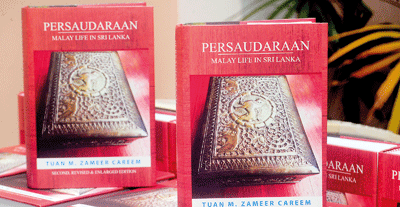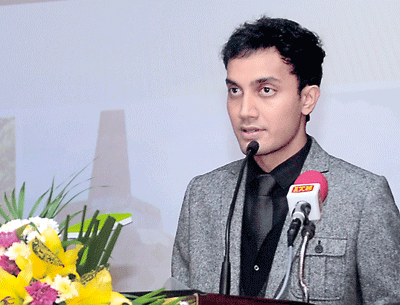Malays as part of Sri Lanka’s multicultural mosaic and a wider diaspora
View(s):Persaudaraan, the Revised and Upgraded Edition, is an anthropological tome written by Tuan. M. Zameer Careem, a Sri Lankan Malay medical student who has in this enlarged edition provided an insight into the unique way of life of Malays, an ethnic minority living in Sri Lanka. Tuan M. Zameer Careem already has a number of publications on Malays of Sri Lanka, and this is his latest.
 The title of the book conveys the thrust of the writer’s argument: Sri Lanka’s diverse community has helped create multicultural Sri Lanka and the rich, vibrant and complex Malay entity has further enriched the nation’s multicultural mosaic.
The title of the book conveys the thrust of the writer’s argument: Sri Lanka’s diverse community has helped create multicultural Sri Lanka and the rich, vibrant and complex Malay entity has further enriched the nation’s multicultural mosaic.
The origin of Malays in Sri Lanka can be traced to two different entities, the first set of Malays came to Ceylon during Dutch colonialism from Celebes, Java and Sumatera, currently part of the Indonesian archipelago and the second group, mainly soldiers and mercenaries arrived on the Lankan shores during British rule from current Malaysia. This book takes a diachronic and synchronic approach discussing the existence of Sri Lankan Malays through colonial influences of the Portuguese, British and Dutch in 21 chapters.
In the preface, the writer contextualizes these Malays in Sri Lanka and their relationship with their ancestors’ land. Malays in early Sri Lanka have been discussed in chapter one which focuses on their distribution mainly in the coastal area of the island. It is followed by the discussion on their socio-economic activities and involvement in the politics of Sri Lanka.
As indicated by the author, this edition really is a new book, with more than 50 percent of the contents, consisting of new research material and I do agree with the author’s claim that Sri Lankan Malays stand out with three extraordinary elements, cuisine, the Creole version of Malay language and the quintessential Malay costumes and jewellery (p.38).

The medical student cum author speaking at the book launch on Wednesday. Pix by Amila Gamage
The writer elaborately discusses the earlier history and achievement of the Malays in Sri Lanka from chapter three to chapter eleven. They showed their loyalty to the local kings, served and even died together with the locals against colonialism. The loyalty to the Kandyan court shows that the Malays despite their Malay/ Indonesian origin managed to gain the trust of the local Nayaka Kings. Being loyal to the masters whether it was to the Kandyan court or the colonial government, the Malays have always played a pivotal role in the security and bureaucracy of the nation. There were cases where the British colonial government badly treated the Ceylonese which the author has discussed in detail in some of the chapters on British Colonialism.
He has described how Britain destroyed Ceylon through looting, expropriation, bloody battles and outright theft but he has seized every opportunity to praise the martial prowess of the Ceylon Rifle Regiment. The Malays in the British era continuously showed their strength and capabilities and managed to gain recognition especially through the much acclaimed Rifle Regiment.
Other achievements of the Malays are discussed in chapter five on Honours and Service (p. 78-86).
The book also narrates some of the misconduct carried out by Malays such as treachery, immorality, etc and the stories have been unravelled in the chapter following British rule.
As this book is interwoven synchronically with many aspects, few personalities who have contributed to the Malay presence in the history of Sri Lanka like Malay Royals and Malay Military Chiefs are also indicated in the book.
The author shows that while Sri Lankan Malays have accepted and adopted some of the local cultural practices they have their distinctive Malay rituals that date back several centuries. The culture of the Malay diaspora in Sri Lanka is discussed in chapters like Exiled Royalty and Fashion, Sri Lankan Malay Culture and Typical Malay Wedding and Rituals.
The book also includes many other aspects of Language, literature and literary activities discussed in detail in the chapter dedicated to Language and Literature. The author has also discussed the Baba and Nyonya, a sub ethnic Malay group in Sri Lanka, a community closely related to the Cina Peranakan (Hybrid Chinese) of Malaysia. The Sri Lankan Malays have also maintained age old performing arts and incorporated them as part of their leisure activities and it is evident that the Malays hold strong imprints in the music and film industry of Sri Lanka (p.468).
Tuan M. Zameer Careem offers a suitably scholarly and informative account on Sri Lankan Malays which helps to explain their importance in terms of history, social, cultural, economy and politics. The range of references and interviews on which his narratives and analysis have been drawn are very impressive. One of the hallmarks of Tuan M. Zameer Careem’s writing is that he carefully combines his empirical discussions with empirical data and sources. This is the reason the book is valuable not only to Malay sociologists but also to Sri Lankan historians, sociologists and students who want to know more about the Malay ethnic minority in Sri Lanka.
(The reviewer is Dean, Faculty of Arts and Social Sciences, University of Malaya, Kuala Lumpur, Malaysia)
| Persaudaraan- Malay Life in Sri Lanka by Tuan M. Zameer Careem Price: Rs. 3750 Publishers: S. Godage and Brothers (PVT) Ltd. Reviewed by Prof. Dr. Hanafi Hussin | |


